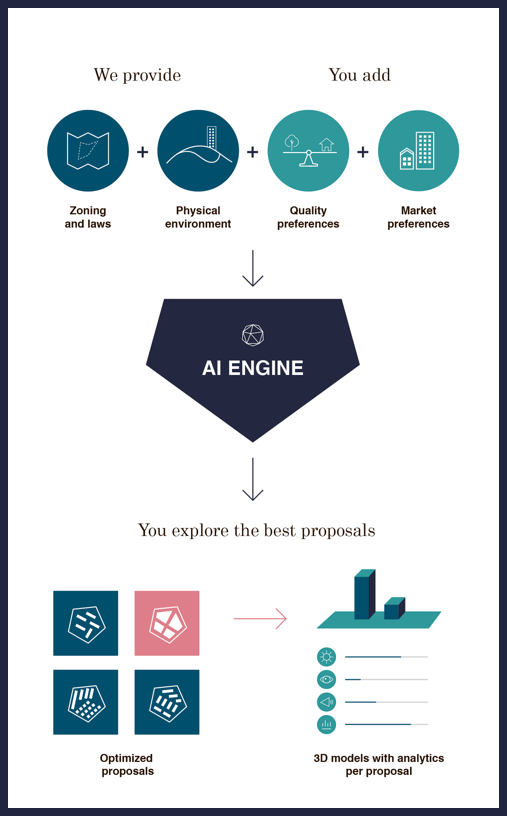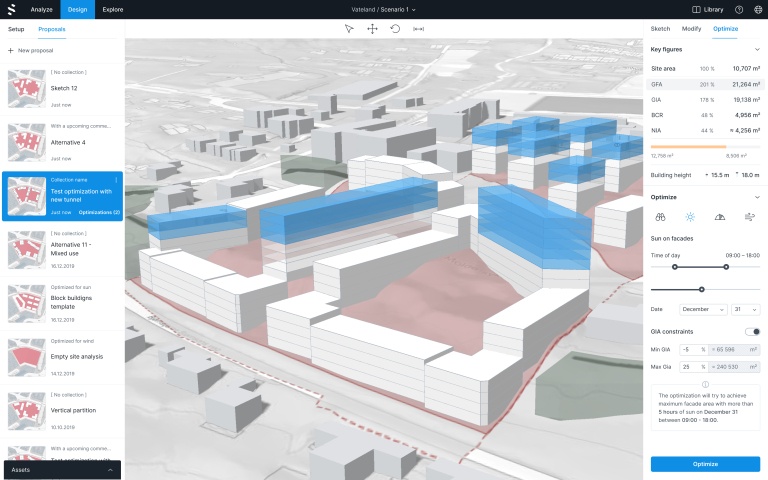Spacemaker: Merging AI technology with Urban Planning and Design

Spacemaker is a cloud-based AI platform that augments the ability of urban designers, architects, and developers to design and build well-planned cities. As part of the company’s operating model, machine learning is used to bring generative design to reality.
The growth of cities places significant pressure on building faster, denser, and with higher standards for quality. However, at the same time, urban development has become more complex, time consuming, and burdened with greater regulations. Spacemaker software seeks to respond to these challenges by cutting down on the time it takes to formulate pre-development design solutions. Early case studies showed building owners saved millions of dollars with the use of the software early in the development process.
The software is licensed to users and supports the quick iteration through thousands of design options. Options are generated from the synthesis of publicly available data sources such as physical, regulatory, environmental, and other forms of inputs used in the designing of large-scale real estate developments. Value is created through three primary services: plan generation, solution analysis, and reiteration of a design options until a desired solution is reached. For real estate developers, the software promises reduced risk, increased project value creation potential, faster and smarter designs, and a seamless collaboration environment among the various team members.
Challenge: Data
Like nearly all AI startups, the company’s software is only as good as the input data. The company faces several data challenges going forward, all of which are necessary hurdles to overcome to offer the full potential of the software. Founded in Norway, the company was built with public access to a rich source of built environment data supported by government entities. However, the limitations with using public data as the basis for the AI are four-fold: public built environment data is fragmented, inconsistent, lacks control, and is often unavailable. While Norway leads the world for city data and this data was easy for the company to initially acquire, many countries and cities are less developed in this regard. This presents a significant challenge for Spacemaker to expand the functions of the software universally across geographies.
Opportunity: Acquired by Autodesk
In November of 2020, Spacemaker was acquired by the AEC software giant Autodesk for $240 million. The Spacemaker CEO saw the acquisition as a path to extending the software more broadly and faster. Spacemaker believes they have only built 5% of what can be done with the software and that tying the software into the broader Autodesk ecosystem will allow them to both extend the technology and access a deep trove of building data generated from the company’s suite of products.
Challenge/Opportunity: Asset Type Expansion
The software currently only can support the development of design options for multifamily residential. For the software to branch out to support the design of other asset types like office and retail, new forms of data and tweaks to the machine learning will be necessary. The features and principles that guide housing design will need to be replaced with a machine learning model that is able to recognize the desirable features for each additional asset type. This is a challenge from a time and labor perspective, not necessarily technical, and relatively easy to overcome.
Challenge: Simulating and/or Supporting Human Intuition
Another significant challenge the company faces going forward is balancing the capabilities of the technology with those of the user. Spacemaker 1.0 was developed initially with limited flexibility to adjust the results outputted by the AI. Through user feedback they quickly discovered that relying so much on the AI technology eliminated the natural intuition of the urban planner or architect in the process, which cannot be easily computed mathematically. The company found that this was a major error and then worked on a second version of the software that allowed for human intuition to be injected more easily into the AI driven results. Critics still worry about the creation of an urban design echo chamber, where “viable” layouts are endlessly reproduced, never challenged, questioned, or evolved. If design is based on data sets from prior understanding of built space, then the opportunity to dream up new urban experiences may be curtailed while precluding our built environment from evolving in the future.
Conclusion
Despite the challenges the company faces to the expand functionality of its product and in acquiring a robust set of city data for diverse geographies, the future is bright for Spacemaker. The acquisition by Autodesk will catapult its user base overnight as it gets bundled into existing software suites. As development costs rise, the pressure to find solutions for improving design while cutting costs will drive more users to adopt the software as a necessary component to compete in the real estate development market.
Alex Moltzau, “The Rise and Rise of Spacemaker AI,” Towards Data Science, June 19, 2019, https://towardsdatascience.com/the-rise-and-rise-of-spacemaker-ai-5c800a001caa, accessed April 2021.
Erin Tallman, “Architects Use AI Software to Progress,” Archi Expo E-Mag, March 25, 2020, http://emag.archiexpo.com/interview-homebound-due-to-the-coronavirus-outbreak-architects-use-ai-software-to-progress/, accessed April 2021.
Per Wessel Nore, “How Steen & Strøm and Storebrand use Spacemaker for site development” Spacemaker, March 26, 2021, https://www.spacemakerai.com/blog/how-steen-strom-and-storebrand-use-spacemaker-for-site-development, accessed April 2021.
Steve O’Hear, “Spacemaker, AI software for urban development, is acquired by Autodesk for $240M”, TechCrunch, November 17, 2020, https://techcrunch.com/2020/11/17/spacemaker-ai-software-for-urban-development-is-acquired-by-autodesk-for-240m/?guccounter=1&guce_referrer=aHR0cHM6Ly93d3cuZ29vZ2xlLmNvbS8&guce_referrer_sig=AQAAAFUoTQ_QaYOs6x1JmUcxGkB28reA0c70CXK5nC_r2xCZUe_Rjv1_7S6HQriH9dLy75TRb4KFXDWbW4tYD_ibuvJvyjk1JVzwFk76DmKyWSLFsMSQL1Zn8pdD86MUKxZOg2gIWh-gpyMXqW3JUOPv7szGPkyJYvn7zjaWZCAtr6iH, Accessed April 202






Thanks Kyle for an interesting blog post! I was just wondering if designers and urban planners would like this product or not. It reminded me of the Watson case we had in the class and how doctors didn’t like the product because they can do their work without a help of AI and I wondered if it applies in this case or not. As you said, AI may not be a great way to come up with something very creative and so I thought the designers and urban planners would not want to rely on the product so much even if they are facing lots of pressure to cut costs.
Very interesting company! Thanks for sharing. I agree that “the pressure to find solutions for improving design while cutting costs will drive more users to adopt the software as a necessary component to compete in the real estate development market.” This is something that is top of mind for many – what is the future or real estate, what are the tools that are disrupting the market, and how can we better plan “smart” cities. I think this company is going to do extremely well as we continue to think differently about real estate and the possibilities as our finger tips – especially using AI.